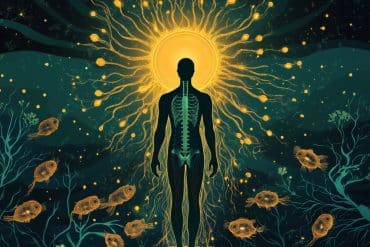Summary: Researchers have successfully transplanted human neurons to treat symptoms of spinal cord injury in mice. The researchers believe this could pave the way for eventual treatment in humans.
Source: UCSF.
Chronic pain and loss of bladder control are among the most devastating consequences of spinal cord injury, rated by many patients as a higher priority for treatment than paralysis or numbness. Now a UC San Francisco team has transplanted immature human neurons into mice with spinal cord injuries, and shown that the cells successfully wire up with the damaged spinal cord to improve bladder control and reduce pain. This is a key step towards developing cell therapies for spinal cord injury in humans, say the researchers, who are currently working to develop the technique for future clinical trials.
Recent mouse studies have demonstrated that transplants of neurons may be effective treatments for neuropathic pain, epilepsy, and even Parkinson’s disease. The new study – published Sept. 22, 2016, in Cell Stem Cell – is the first to successfully transplant human neurons as a treatment for symptoms of spinal cord injury.
“This is an important proof of principle for using cell therapy to repair damaged neural tissue. It brings us one step closer to using such transplants to bring much needed relief to people with spinal cord injuries,” said co-senior author Arnold Kriegstein, MD, PhD, who is a professor of developmental and stem cell biology and director of the Eli and Edythe Broad Center of Regeneration Medicine and Stem Cell Research at UCSF.

Quarter of a Million People Live With Spinal Cord Injuries
Currently, over a quarter of a million people in the U.S. live with spinal cord injuries, and 17,000 new cases occur each year, according to the National Spinal Cord Injury Statistical Center. In addition to paralysis and loss of sensation, recent estimates suggest that more than half of patients with spinal cord injury go on to develop chronic neuropathic pain, and nearly all develop bladder dysfunction. In addition to being painful, the inability to empty the bladder leads to back up in the urinary system that can result in kidney damage.
“The field has been very focused on restoring patients’ ability to walk, perhaps because that’s often their most visible impairment,” said co-senior author Linda Noble-Haeusslein, PhD, who is the Alvera L. Kan Endowed Chair of Neurological Surgery and a professor of physical therapy and rehabilitation at UCSF. But a 2004 study that directly asked patients with spinal cord injury about their experiences found that nearly 20 percent of paraplegics and 10 percent of quadriplegics ranked bladder control as their highest priority for treatment, while fewer patients prioritized walking.
“That study suggested that we had really missed the boat as a field,” said Noble-Haeusslein, who is also co-director of UCSF’s Neurobehavioral Core for Rehabilitation Research. “It caused us to dramatically shift what we do in the lab.”
Chronic pain and loss of bladder control are caused by wide-spread inflammation immediately following acute spinal injuries, which can lead to more wide-spread damage further from the site of injury. In particular, inflammation damages inhibitory neural circuitry that uses the neurotransmitter GABA to keep spinal circuits’ activity under control. When GABA-producing cells are weakened, the spinal cord loses control over circuits controlling pain sensation as well as those responsible for emptying the bladder.
Previously, researchers led by Kriegstein’s collaborator Allan Basbaum, PhD, chair of anatomy at UCSF, successfully treated neuropathic pain caused by peripheral nerve damane by transplanting GABA-producing medial ganglionic eminence (MGE)-like cells derived from mouse stem cells into the uninjured spinal cord. In another recent study, Scott C. Baraban, PhD, who holds the William K. Bowes Jr. Endowed Chair in Neuroscience Research at UCSF, successfully controlled seizures in epileptic mice by transplanting mouse MGE-like cells into the hippocampus, a brain region where seizures often begin.
In the new paper, Noble-Haeusslein and Kriegstein took these efforts a step closer to therapies that could be used in human patients by testing whether human GABA-producing cells could effectively integrate into the damaged spinal cord and improve bladder dysfunction and chronic pain.
They caused lab-grown human embryonic stem cells to differentiate into MGE-like inhibitory neuron precursors, then transplanted the immature human cells into mice two weeks following injury of the thoracic spinal cord (about half-way up the back). Six months later, the cells, which had been introduced just below the inflamed lumbar region of the spine where bladder function is controlled, had successfully migrated toward the site of injury, developed into mature inhibitory neurons and made synaptic connections with the local spinal cord circuitry.

While untreated mice with spinal cord injuries developed hypersensitivity to touch and painful stimuli as well as abnormal scratching and grooming, mice with new human inhibitory neurons showed significantly fewer of all these signs of neuropathic pain by three to six months after transplantation. Treated mice also exhibited significantly improved bladder function – measured by decreased bladder pressure, lower amounts of urine in the bladder, and improved function of bladder muscles. As a result, the researchers observed, the mice were able to produce more normal, voluntary patterns of urination in their cages.
Paving the Way for Cell Therapy Trials in Humans
The researchers hope the new findings will lead to the use of neural progenitors to improve the lot of patients with spinal cord injury, but Noble emphasizes that clinical trials are still a long way off: “This was a trial run,” Noble-Haeusslein said. “There’s still much to optimize going forward.”
First, researchers will need to replicate the findings, and investigate the optimal timing of the intervention for improving bladder control and chronic pain. There are also safety concerns regarding transplanting neurons into the spinal cord: although the researchers saw no evidence of negative impacts on movement control or other spinal functions in experiments in uninjured control mice, more detailed safety studies still need to be done.
Nevertheless, the researchers emphasize the new study should be cause for cautious optimism among spinal cord patients: “This is a very important step,” Kriegstein said. “It shows efficacy of a human cell therapy for neuropathic pain and bladder dysfunction in an animal model of spinal cord injury. The next step on the way to the clinic and a trial in patients is scaling up production of the interneuron precursors facilities that meet FDA quality and safety standards.”
Kriegstein and co-author Cory Nicholas, PhD, are co-founders of Neurona Therapeutics, a startup company that is developing human MGE-like cells for future clinical trials.
Thomas Markus Fandel, MD, was first author on the new paper. Additional authors on the paper were Alpa Trivedi, PhD, Haoqian Zhang, PhD, Jiadong Chen, PhD, and Aida Fernanda Martinez, BS.
Funding: The research was supported by the US National Institute of Health Challenge Grant RC1 NS068200, the California Institute of Regenerative Medicine Early Translational Research Grant TR3-05606, and philanthropic support from Mr. Robert Sieker.
Source: Nicholas Weiler – UCSF
Image Source: NeuroscienceNews.com images are credited to Cory Nicholas and Jiadong Chen.
Original Research: Full open access research for “Transplanted Human Stem Cell-Derived Interneuron Precursors Mitigate Mouse Bladder Dysfunction and Central Neuropathic Pain after Spinal Cord Injury” by Thomas M. Fandel, Alpa Trivedi, Cory R. Nicholas, Haoqian Zhang, Jiadong Chen, Aida F. Martinez, Linda J. Noble-Haeusslein, and Arnold R. Kriegstein in Cell Stem Cell. Published online September 22 2016 doi:10.1016/j.stem.2016.08.020
[cbtabs][cbtab title=”MLA”]UCSF “Human Neuron Transplants Treat Spinal Cord Injury in Mice.” NeuroscienceNews. NeuroscienceNews, 23 September 2016.
<https://neurosciencenews.com/spinal-cord-neuron-transplant-5113/>.[/cbtab][cbtab title=”APA”]UCSF (2016, September 23). Human Neuron Transplants Treat Spinal Cord Injury in Mice. NeuroscienceNew. Retrieved September 23, 2016 from https://neurosciencenews.com/spinal-cord-neuron-transplant-5113/[/cbtab][cbtab title=”Chicago”]UCSF “Human Neuron Transplants Treat Spinal Cord Injury in Mice.” https://neurosciencenews.com/spinal-cord-neuron-transplant-5113/ (accessed September 23, 2016).[/cbtab][/cbtabs]
Abstract
Transplanted Human Stem Cell-Derived Interneuron Precursors Mitigate Mouse Bladder Dysfunction and Central Neuropathic Pain after Spinal Cord Injury
Highlights
•Human embryonic stem cells differentiate into MGE-like interneuron precursors
•Transplanted cells functionally integrate into the injured mouse spinal cord
•Mice with transplanted cells have reduced pain-related behaviors
•Transplanted mice also show improvement in neurogenic bladder dysfunction
Summary
Neuropathic pain and bladder dysfunction represent significant quality-of-life issues for many spinal cord injury patients. Loss of GABAergic tone in the injured spinal cord may contribute to the emergence of these symptoms. Previous studies have shown that transplantation of rodent inhibitory interneuron precursors from the medial ganglionic eminence (MGE) enhances GABAergic signaling in the brain and spinal cord. Here we look at whether transplanted MGE-like cells derived from human embryonic stem cells (hESC-MGEs) can mitigate the pathological effects of spinal cord injury. We find that 6 months after transplantation into injured mouse spinal cords, hESC-MGEs differentiate into GABAergic neuron subtypes and receive synaptic inputs, suggesting functional integration into host spinal cord. Moreover, the transplanted animals show improved bladder function and mitigation of pain-related symptoms. Our results therefore suggest that this approach may be a valuable strategy for ameliorating the adverse effects of spinal cord injury.
“Transplanted Human Stem Cell-Derived Interneuron Precursors Mitigate Mouse Bladder Dysfunction and Central Neuropathic Pain after Spinal Cord Injury” by Thomas M. Fandel, Alpa Trivedi, Cory R. Nicholas, Haoqian Zhang, Jiadong Chen, Aida F. Martinez, Linda J. Noble-Haeusslein, and Arnold R. Kriegstein in Cell Stem Cell. Published online September 22 2016 doi:10.1016/j.stem.2016.08.020






